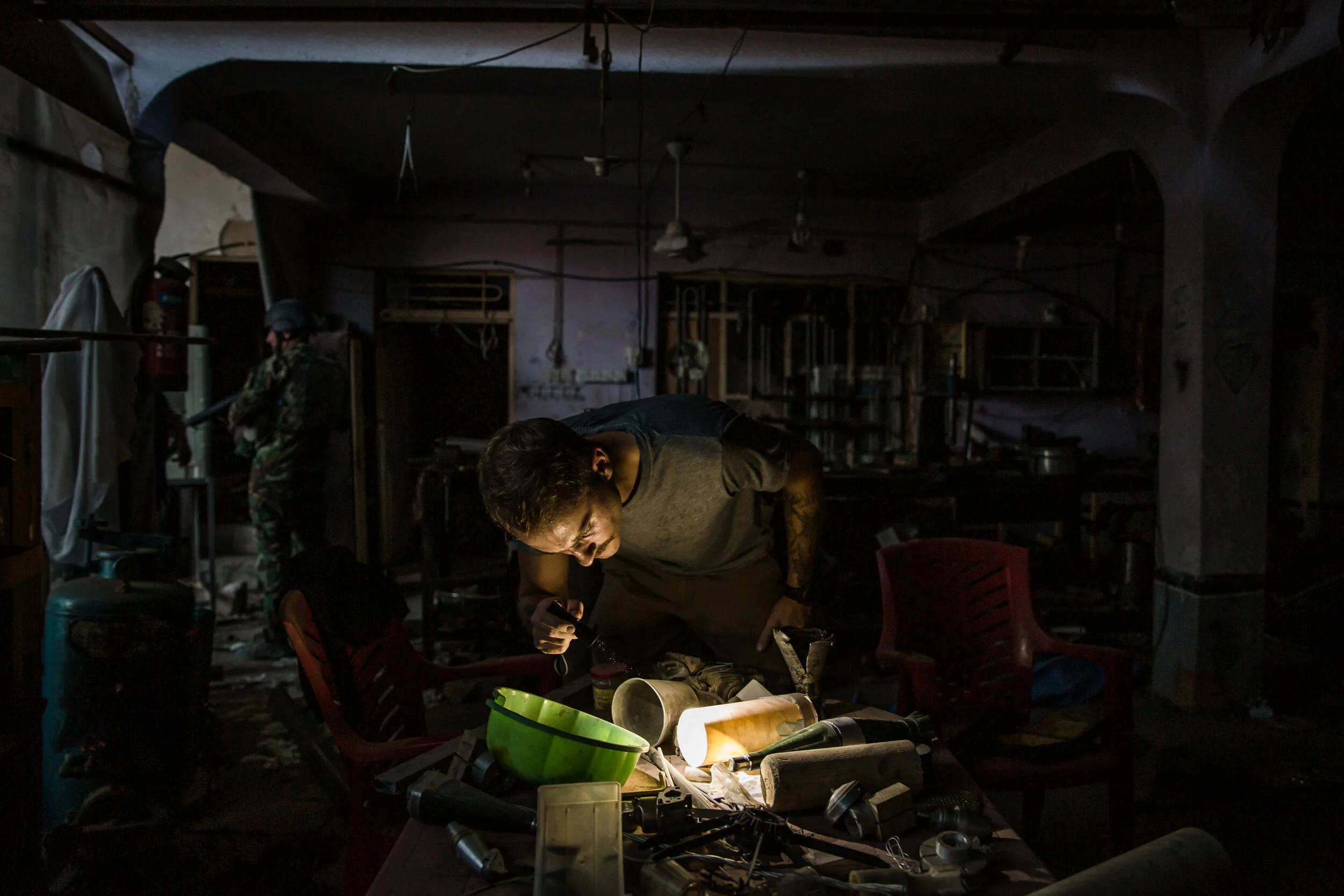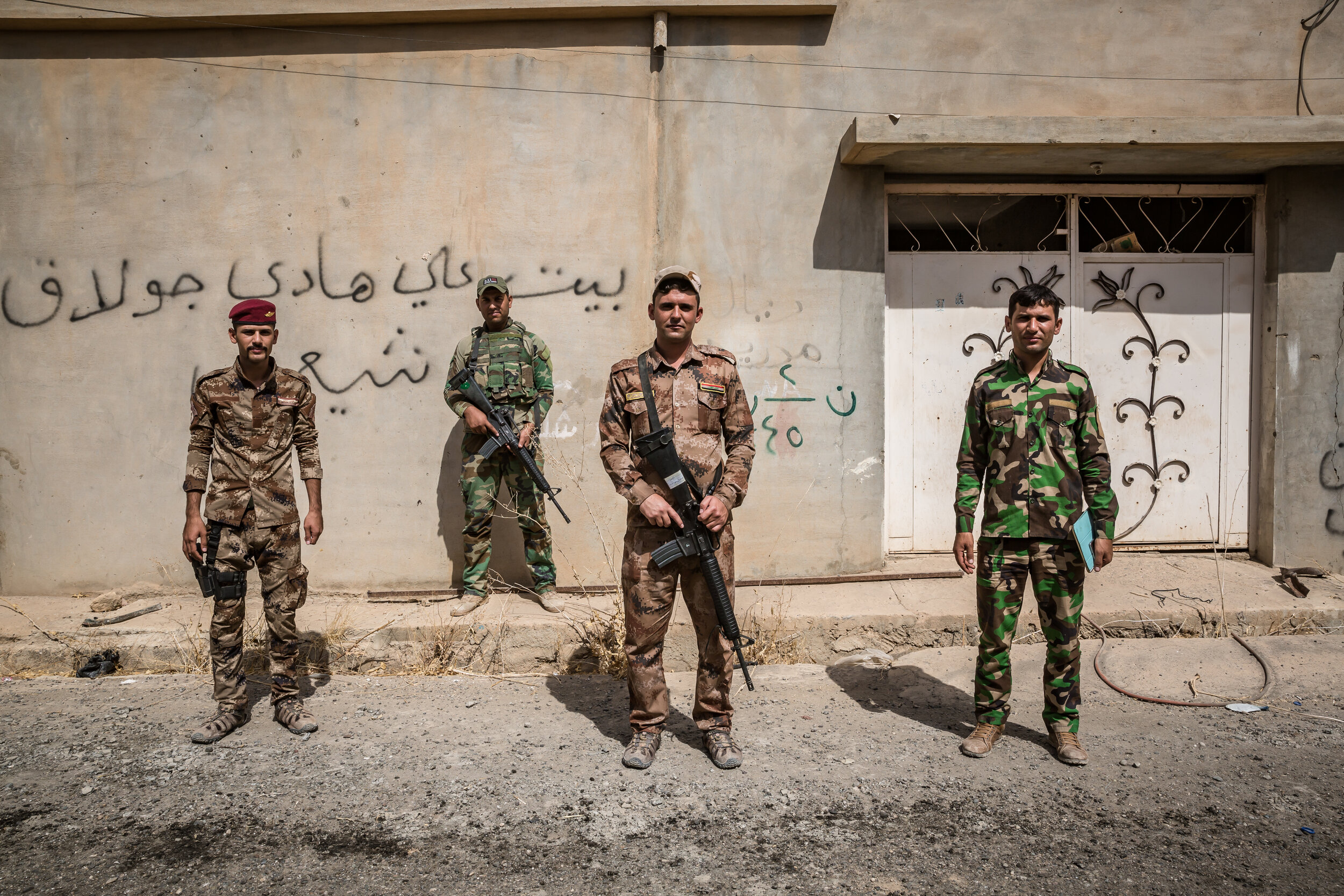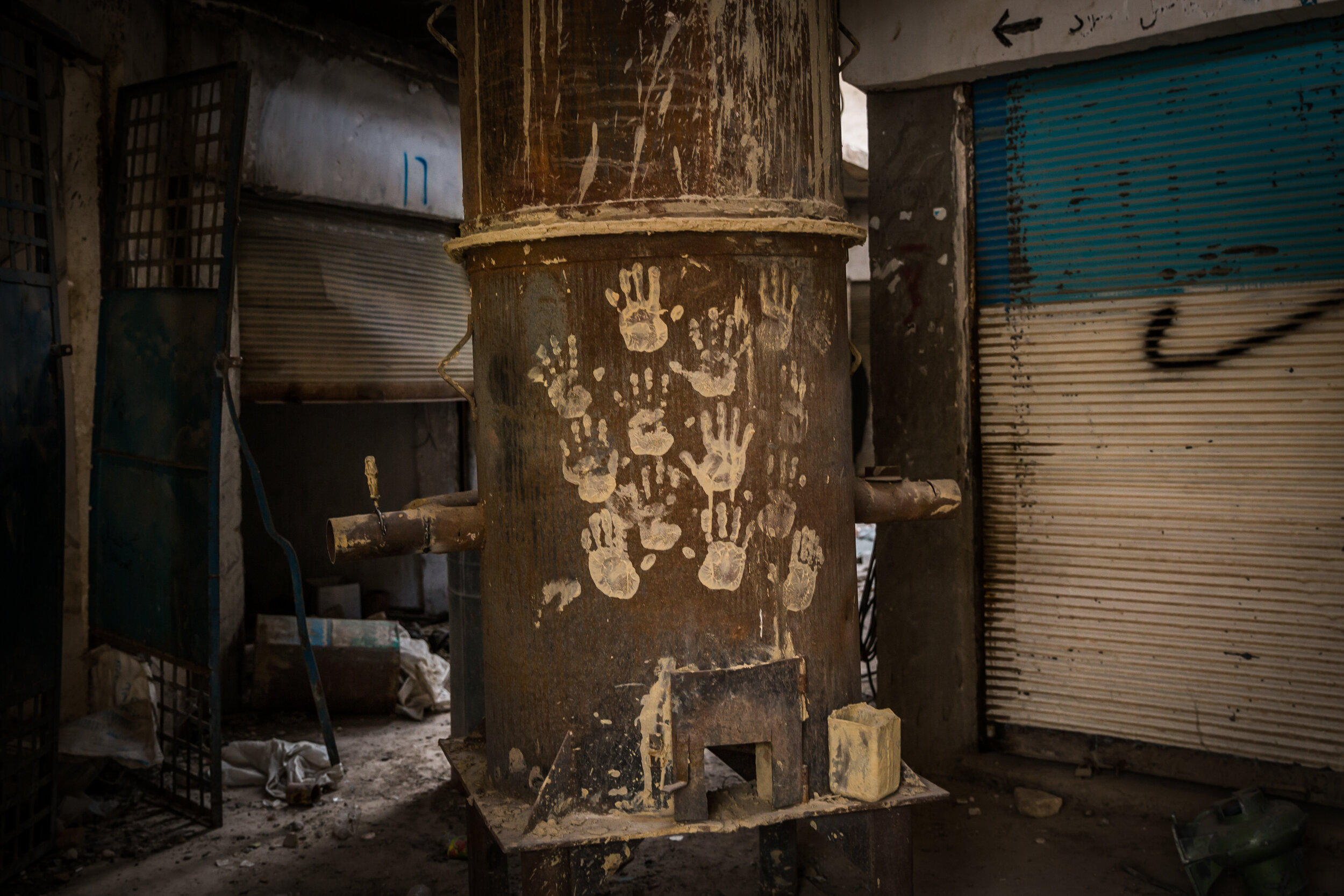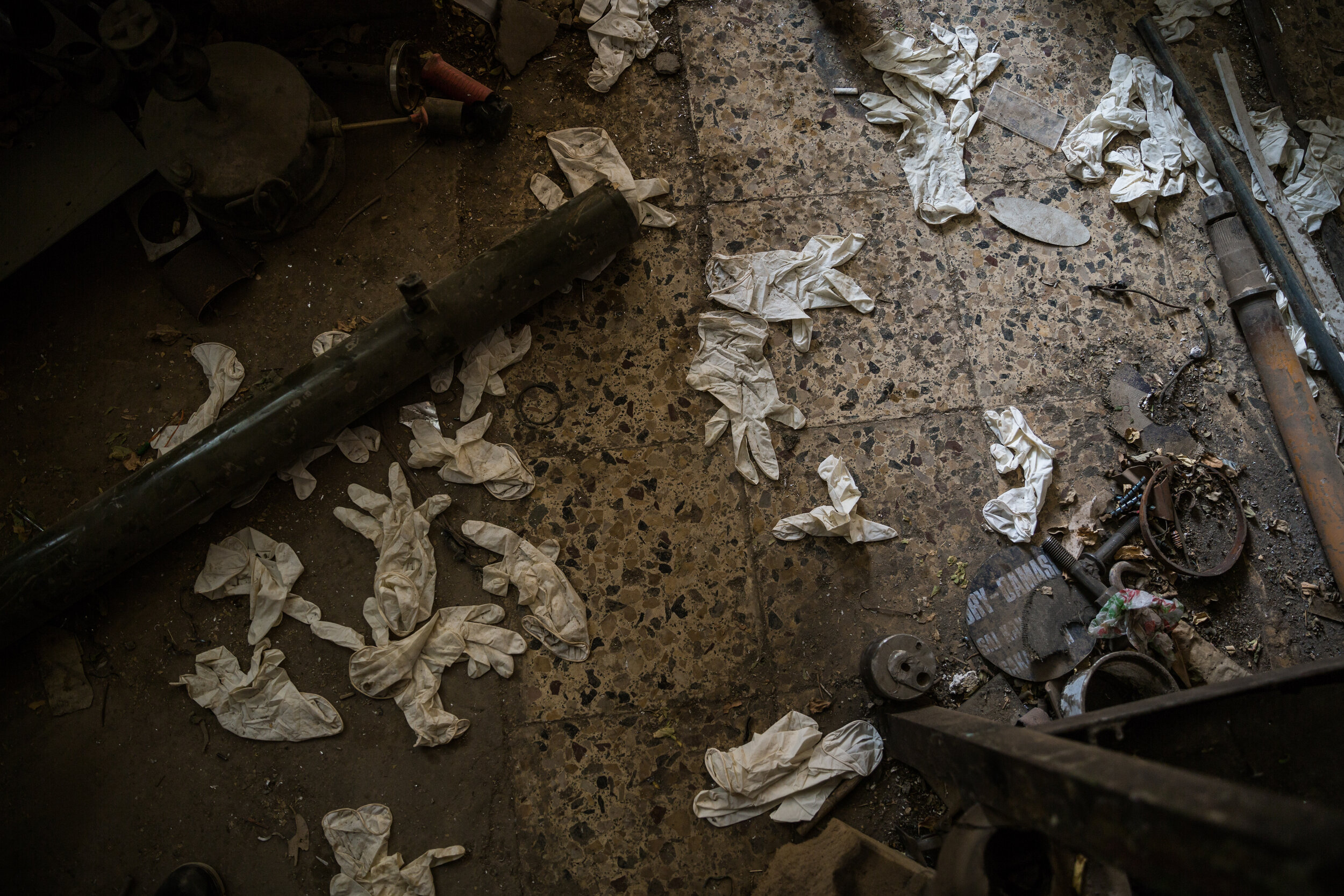
Damien Spleeters pours over half constructed bombs and disassembled rocket parts on a table in a large warehouse in Tel Afar, northern Iraq. The warehouse was recently abandoned by the Islamic State (ISIS).
For Spleeters, a field investigator for Conflict Arms Research, the warehouse is a goldmine for documenting ISIS-modified weapons. The factory appears to have been abandoned in a hurry. ISIS did not put up much resistance in Tel Afar, a strategic village they once occupied between Mosul, Iraq and Raqqa, Syria, and Iraqi forces were able to reclaim the city in a matter of days.
There is little evidence that the extremists tried to destroy their weapon’s factories or transport weapons and ordnance elsewhere. Nevertheless, Iraqi forces typically sweep newly liberated territory confiscating any weapons that might be absorbed into their own weapons cache or be better destroyed. Spleeters works against the clock to document these locations before their contents disappear.

Homemade 119.5-mm mortar castings lay discarded in the main civilian market of Tel Afar, Iraq. After running out of the caches of weapons they captured from the Iraqi and Syrian governments, the Islamic State did something no other terror group had ever done: they designed and build their own ordnance.
This part of the market was repurposed by the Islamic State (ISIS) and turned into a smelting factory for homemade ISIS-produced mortars. Researchers always suspected this part of the market was used for producing weapons. The traditional narrow alleyways and tarp covering designed to protect the people and produce of the market from the sweltering summer heat proved to be a successful cover for manufacturing and transporting weapons, without the watchful eyes of drones tracking their progress.

A flipped over and dismantled Islamic State police car lies discarded in the medium between streets in Tal Afar, northern Iraq. According to ISIS propaganda websites, the cars provided governance in the Caliphate, aiming to 'implement the orders of the religious judiciary'.

Members of the Iraqi Army Intelligence division stand outside an unassuming family home-turned ISIS weapon’s production factory they discovered in Tel Afar, Iraq. The Iraqi Army collaborates with Conflict Arms Research in order to gain greater understanding of the extremists weapons industry and chains of supply. Conflict Arms Research, an international organization funded by the European Union, specializes in investigating the use of illicit weapons and weapon building material to mitigate the supply of conventional arms to unauthorized uses, such as the Islamic State.

A furnace used for smelting Islamic State-made mortars in the main civilian market of Tel Afar, Iraq. This part of the market was repurposed by the Islamic State (ISIS) and turned into a smelting factory for homemade ISIS mortars. According to the Iraqi Army, the handprints appear to be a type of autograph left by the ISIS mortar makers.

Having arrived at one of the large ISIS warehouses in Tel Afar at night, Spleeters returned the next day to be able to measure, photograph, and catalogue as much of the location as possible before sun down. Here, he pauses for a moment during the dangerous work of handling ordnance.

The town center of Tel Afar, Iraq. The city is strategically located along the main highway between two of ISIS’s most important cities: Raqqa and Mosul. This made the remote desert town a choice location for much of ISIS' deadly weapon manufacturing facilities. While the city of Tal Afar once had a population of around 200,000, it was virtually deserted when Iraqi security forces retook the city, surprising the forces and humanitarian actors prepared to receive civilians.

The majority of the arms confiscated from the Islamic State were manufactured outside the country. But not all. This rifle has the distinct etching of al-Asqa Mosque on the rear sight block, signifying it is a Tabuk Sniper Rifle, a 7.62 x 39 mm assault rifle produced in Iraq.

Sweat marks from Spleeters Go-Pro camera soil his T-shirt after hours of documenting ordnance in the Iraqi autumn heat. At 31, Spleeters has spent the past three years investigator weapons in Iraq, Syria, Mail, and Libya.

A worktable abandoned in a hurry by the Islamic State in Tel Afar, Iraq. Spleeters long suspected that the Islamic State was designing and modifying their own weapons. This table is a collection of ISIS-designed bomblets, injection-molded plastic bodies, ISIS-designed fuses, and small tail kits for stabilization all waiting to be assembled into ISIS’s deadly drone bombs or shot from a modified rifle.


Down in Baghdad, the Iraqi Amy Intelligence division opens up their storage warehouses to Conflict Arms Research field investigator, Damien Spleeters, to document what they confiscated recently. A sheep, to-be dinner for the base, wanders into one of the warehouses storing caches of assault weapons confiscated from the Islamic State in Mosul. Cheap Chinese rifles, like those propped up against the wall on the right, are abundant.

Spleeters prepares a round of ammunition confiscated from the Islamic State to photograph, measure, and catalogue as part of the process of tracing the origins of every available piece of arms and ordnance used by the Islamic State. Conflict Arms Research has conducted 83 site visits in Iraq, cataloguing 1,832 recovered weapons and 40,984 pieces of recovered ammunition.

A defaced image of the important Shia figure Imam Ali Hussain and a lion hangs above the entrance way of a family home in Tel Afar, Iraq. Any image of a human face is forbidden in accordance to the Islamic States strict interpretation of Islamic law. The faces of animals and cartoon characters painted along primary school walls were also commonly defiled.

A common insurgency weapon: three crudely made improvised explosive devices (IEDs) sit abandoned in one of the Islamic State’s production facilities in Tel Afar, Iraq. IEDs were used extensively against US forces during the American-led invasion of Iraq in 2003. Similar devices were again used by the Islamic State against Iraqi security forces.

ISIS modified fuses. For safety reasons, most countries develop specific fuzes to go with specific weapons. But the Islamic State valued simplicity and designed one fuze that could work on an array of weapons: their own rockets, mortars, and bomblets. It was a significant engineering undertaking.

Documenting the documenter: Damien Spleeters of Conflict Arms Research examines the inside one of the many ISIS-manufactured rockets found inside a family home-turned weapons warehouse in Tal Afar, northern Iraq.
ISIS' network of munition factories have produced two main types of rockets: a smaller rocket about 2.5 feet in length and a longer one (pictured) measuring almost 6 feet. These products are made from scratch using a combination of steel, plastic, and aluminum, each one adhering to a standard weight and diameter.

Abandoned ISIS-manufactured rockets show the extent of which these ordnance were mass produced by the Islamic State, something no other terrorist group has ever achieved before.

Iraqi Army Major Ahmed al-Abadi, is tasked with accompanying Conflict Arms Researcher Damien Spleeters on his field investigation in Tal Afar, northern Iraq

Spleeters photographs one of the 119.5 ISIS-made mortars in a building the extremists abandoned when they lost control of Tel Afar in northern Iraq. Mortars typically come in standard sizes, such as 60mm, 81mm, 120mm, but ISIS needed to produce a slightly atypical size to fit in the repurposed steel pipes they used for launch tubes.

A cat wonders into an abandoned Islamic State weapon’s production factory.

On the road back from the city center of Tel Afar, Iraqi soldiers apprehend a local shepherd. While Tel Afar was liberated almost a month earlier, civilians are still banned from certain military zones, which this shepherd may or may not have accidentally wandered into.

Spleeters watches TV and relaxes under the watchful eyes of important Shia figures Imam Ali Hussain and Abbas ibn Ali at the Iraqi military base that will be his lodging during his field investigation in Tel Afar, Iraq.

The Iraqi flag waves in the sunrise as an Iraqi military intelligence convoy begins the long road accompanying Spleeters back to Baghdad after his work was done.
Damien Spleeters pours over half constructed bombs and disassembled rocket parts on a table in a large warehouse in Tel Afar, northern Iraq. The warehouse was recently abandoned by the Islamic State (ISIS).
For Spleeters, a field investigator for Conflict Arms Research, the warehouse is a goldmine for documenting ISIS-modified weapons. The factory appears to have been abandoned in a hurry. ISIS did not put up much resistance in Tel Afar, a strategic village they once occupied between Mosul, Iraq and Raqqa, Syria, and Iraqi forces were able to reclaim the city in a matter of days.
There is little evidence that the extremists tried to destroy their weapon’s factories or transport weapons and ordnance elsewhere. Nevertheless, Iraqi forces typically sweep newly liberated territory confiscating any weapons that might be absorbed into their own weapons cache or be better destroyed. Spleeters works against the clock to document these locations before their contents disappear.
Homemade 119.5-mm mortar castings lay discarded in the main civilian market of Tel Afar, Iraq. After running out of the caches of weapons they captured from the Iraqi and Syrian governments, the Islamic State did something no other terror group had ever done: they designed and build their own ordnance.
This part of the market was repurposed by the Islamic State (ISIS) and turned into a smelting factory for homemade ISIS-produced mortars. Researchers always suspected this part of the market was used for producing weapons. The traditional narrow alleyways and tarp covering designed to protect the people and produce of the market from the sweltering summer heat proved to be a successful cover for manufacturing and transporting weapons, without the watchful eyes of drones tracking their progress.
A flipped over and dismantled Islamic State police car lies discarded in the medium between streets in Tal Afar, northern Iraq. According to ISIS propaganda websites, the cars provided governance in the Caliphate, aiming to 'implement the orders of the religious judiciary'.
Members of the Iraqi Army Intelligence division stand outside an unassuming family home-turned ISIS weapon’s production factory they discovered in Tel Afar, Iraq. The Iraqi Army collaborates with Conflict Arms Research in order to gain greater understanding of the extremists weapons industry and chains of supply. Conflict Arms Research, an international organization funded by the European Union, specializes in investigating the use of illicit weapons and weapon building material to mitigate the supply of conventional arms to unauthorized uses, such as the Islamic State.
A furnace used for smelting Islamic State-made mortars in the main civilian market of Tel Afar, Iraq. This part of the market was repurposed by the Islamic State (ISIS) and turned into a smelting factory for homemade ISIS mortars. According to the Iraqi Army, the handprints appear to be a type of autograph left by the ISIS mortar makers.
Having arrived at one of the large ISIS warehouses in Tel Afar at night, Spleeters returned the next day to be able to measure, photograph, and catalogue as much of the location as possible before sun down. Here, he pauses for a moment during the dangerous work of handling ordnance.
The town center of Tel Afar, Iraq. The city is strategically located along the main highway between two of ISIS’s most important cities: Raqqa and Mosul. This made the remote desert town a choice location for much of ISIS' deadly weapon manufacturing facilities. While the city of Tal Afar once had a population of around 200,000, it was virtually deserted when Iraqi security forces retook the city, surprising the forces and humanitarian actors prepared to receive civilians.
The majority of the arms confiscated from the Islamic State were manufactured outside the country. But not all. This rifle has the distinct etching of al-Asqa Mosque on the rear sight block, signifying it is a Tabuk Sniper Rifle, a 7.62 x 39 mm assault rifle produced in Iraq.
Sweat marks from Spleeters Go-Pro camera soil his T-shirt after hours of documenting ordnance in the Iraqi autumn heat. At 31, Spleeters has spent the past three years investigator weapons in Iraq, Syria, Mail, and Libya.
A worktable abandoned in a hurry by the Islamic State in Tel Afar, Iraq. Spleeters long suspected that the Islamic State was designing and modifying their own weapons. This table is a collection of ISIS-designed bomblets, injection-molded plastic bodies, ISIS-designed fuses, and small tail kits for stabilization all waiting to be assembled into ISIS’s deadly drone bombs or shot from a modified rifle.
Down in Baghdad, the Iraqi Amy Intelligence division opens up their storage warehouses to Conflict Arms Research field investigator, Damien Spleeters, to document what they confiscated recently. A sheep, to-be dinner for the base, wanders into one of the warehouses storing caches of assault weapons confiscated from the Islamic State in Mosul. Cheap Chinese rifles, like those propped up against the wall on the right, are abundant.
Spleeters prepares a round of ammunition confiscated from the Islamic State to photograph, measure, and catalogue as part of the process of tracing the origins of every available piece of arms and ordnance used by the Islamic State. Conflict Arms Research has conducted 83 site visits in Iraq, cataloguing 1,832 recovered weapons and 40,984 pieces of recovered ammunition.
A defaced image of the important Shia figure Imam Ali Hussain and a lion hangs above the entrance way of a family home in Tel Afar, Iraq. Any image of a human face is forbidden in accordance to the Islamic States strict interpretation of Islamic law. The faces of animals and cartoon characters painted along primary school walls were also commonly defiled.
A common insurgency weapon: three crudely made improvised explosive devices (IEDs) sit abandoned in one of the Islamic State’s production facilities in Tel Afar, Iraq. IEDs were used extensively against US forces during the American-led invasion of Iraq in 2003. Similar devices were again used by the Islamic State against Iraqi security forces.
ISIS modified fuses. For safety reasons, most countries develop specific fuzes to go with specific weapons. But the Islamic State valued simplicity and designed one fuze that could work on an array of weapons: their own rockets, mortars, and bomblets. It was a significant engineering undertaking.
Documenting the documenter: Damien Spleeters of Conflict Arms Research examines the inside one of the many ISIS-manufactured rockets found inside a family home-turned weapons warehouse in Tal Afar, northern Iraq.
ISIS' network of munition factories have produced two main types of rockets: a smaller rocket about 2.5 feet in length and a longer one (pictured) measuring almost 6 feet. These products are made from scratch using a combination of steel, plastic, and aluminum, each one adhering to a standard weight and diameter.
Abandoned ISIS-manufactured rockets show the extent of which these ordnance were mass produced by the Islamic State, something no other terrorist group has ever achieved before.
Iraqi Army Major Ahmed al-Abadi, is tasked with accompanying Conflict Arms Researcher Damien Spleeters on his field investigation in Tal Afar, northern Iraq
Spleeters photographs one of the 119.5 ISIS-made mortars in a building the extremists abandoned when they lost control of Tel Afar in northern Iraq. Mortars typically come in standard sizes, such as 60mm, 81mm, 120mm, but ISIS needed to produce a slightly atypical size to fit in the repurposed steel pipes they used for launch tubes.
A cat wonders into an abandoned Islamic State weapon’s production factory.
On the road back from the city center of Tel Afar, Iraqi soldiers apprehend a local shepherd. While Tel Afar was liberated almost a month earlier, civilians are still banned from certain military zones, which this shepherd may or may not have accidentally wandered into.
Spleeters watches TV and relaxes under the watchful eyes of important Shia figures Imam Ali Hussain and Abbas ibn Ali at the Iraqi military base that will be his lodging during his field investigation in Tel Afar, Iraq.
The Iraqi flag waves in the sunrise as an Iraqi military intelligence convoy begins the long road accompanying Spleeters back to Baghdad after his work was done.























